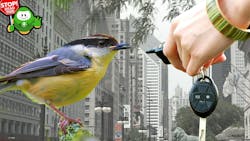Urban Lifestyle Initiative is for the Birds
This article is part of the April 1st series in the Humor section of our Series Library.
What you’ll learn:
- The lingering problem in urban areas today.
- How an initiative is aiming to address and reverse this significant issue.
The highway of progress is littered with many casualties, as various technologies come and go, leaving their market and societal impact long after they have been rendered obsolete. These problems mostly stem from a loss of knowledge about how things were done previously, like a young person not able to operate a rotary telephone, or not know how a slide rule works. Some are lingering echoes of previous technology dominance that still impact the marketplace, like the legacy of fossil fuels steering energy policy.
A Noisy Problem
However, one of the most impactful and terrible technological mistakes of the 1990s left almost indelible traces on every city in the U.S., as well as some other Western nations. The infatuation with loud and obnoxious car alarms almost destroyed the country, depriving people of peace and quiet and sleep. The sounds made by a car alarm were not only loud and shrill, they were sadly predictable, repeating on a regular basis anytime a car with one of the infernal systems inside was disturbed in any way.
During the height of the car-alarm craze, it was impossible to live in an urban area not plagued by their constant and incessant shrill scream. Peace and quiet, already in short supply in cities, was nearly impossible to achieve for almost a decade. The irony was that the noise problem was so stark and painful, nobody cared if the car in question was being stolen or not. It was often vandalized by neighbors to get the damn thing to stop making noise.
One of the issues with the incessant din coming from these blighted cars was the warbling, changing nature of the alarm signal. Most mainstream units went through a series of cacophonous sequences in some vague hope of gaining notice beyond the insane alarm scream. The sequence ran through staccato bleeps, short piping toots, and siren sounds. It was an assault of sound that the poor people of most American cities had to live through and put up with.
The Idiocy Ends, but Problems Remain
The slow migration to factory-provided alarm systems, and the adoption of the external functionality provided by car alarms like remote start and door operation, reduced the demand for car alarms to the point where they’re a thankfully a scarce commodity in cities today. However, their evil impact on urban areas lingers to this very day.
One of the biggest issues with car alarms from the end of the 20th century was that as they made their terrible alarm sounds, they were imprinting the local birds. The loud tones in the morning were interpreted by urban birds as another, bigger bird with a song “sung” louder than theirs. Since birds compete with song, the city birds began to emulate the tone and pattern of car alarms—an unfortunate reaction that impacts how urban birds sound today.
Now, long after the car alarms with their annoyingly shrill sirens are gone, birds still mimic the beep-beep-beep and other sound patterns imprinted on them by the now-extinct noise machines. Unable to sing the songs they no longer know and never hear, much of birdsong in a city today reminds us all of the sad legacy of car alarms and their terrible noisy impact.
The Birdsong Initiative
A group of dedicated ornithologists and bird watchers have started the Birdsong Initiative, which they plan to roll out in every major urban center in the U.S. The plan is to put a huge loudspeaker on top of every building in a downtown area that plays birdsong constantly to condition the local birds to emulate real birdsong.
The leader of the group, Dr. Eno Lirpa, conceded in an interview that the program itself will be loud, but for a good cause. “Yes, for a year or so you’ll have to listen to birdsong at 140 decibels, but at the end of that time, all the birds in your city will be singing a song instead of emulating an alarm sound.”
When asked about the concern that not all birds sing the same song, and that the project will just exchange one pattern of sounds for another, he replied that at least it wouldn’t be a car-alarm pattern. He asserted, “At this point, they could sing the Hokey-Pokey and I’d be cool with that. Anything would be better than that rotating cycle of car-alarm noises.”
It will be interesting to see how the initiative is accepted by city dwellers, but it has high hopes.
Read more articles in our April 1st series in the Humor section of our Series Library.
Here are the prior and next articles in the series
About the Author
Alix Paultre
Editor-at-Large, Microwaves & RF
Alix is Editor-at-Large for Microwaves & RF.
An Army veteran, Alix Paultre was a signals intelligence soldier on the East/West German border in the early ‘80s, and eventually wound up helping launch and run a publication on consumer electronics for the U.S. military stationed in Europe. Alix first began in this industry in 1998 at Electronic Products magazine, and since then has worked for a variety of publications, most recently as Editor-in-Chief of Power Systems Design.
Alix currently lives in Wiesbaden, Germany.





